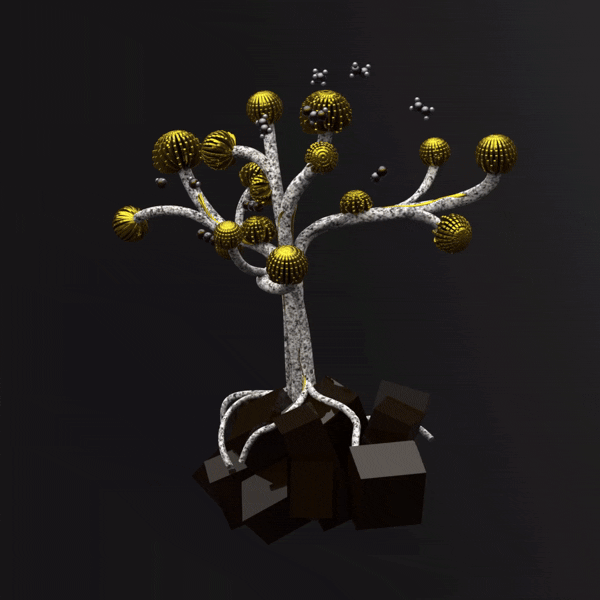Copper nanoflowers bloom on perovskite artificial leaves for solar hydrocarbon synthesis


Over the past seven years, our work helped establish perovskite-BiVO4 artificial leaves as versatile platforms for unassisted CO2 reduction to simple products like syngas, a mixture of CO and H2 which stands as a key intermediate in the industrial liquid fuel synthesis.1,2 For this, the introduction of metal halide perovskite light absorbers with high photovoltages around 1 V proved key to perform reactions beyond water splitting.3 Yet, direct CO2 conversion to ethane and ethylene remained challenging, as substantial catalytic overpotentials must be overcome for hydrocarbon formation. To address this challenge, we set to combine our experience in photoelectrochemical perovskite device fabrication with the leading expertise in CO2 reduction from the group of Prof. Peidong Yang in Berkeley.4,5
To this end, I undertook a 6-month research visit at the University of California, Berkeley, which was kindly supported by the Winton Cambridge - Kavli ENSI Exchange Programme. Planned in 2019 and approved in 2020, the project start was delayed by the worldwide COVID-19 pandemic, which had broad implications from US Visa appointments to Departmental access. The project ultimately began in January 2022, with me and Dr. Inwhan Roh brainstorming ways to interface copper nanoparticle-based catalysts onto the perovskite devices. As is the case in most research projects, assumptions do not necessarily match experimental results. Hence, Cu nanoparticles lost their excellent CO2-to-ethylene selectivity when embedded in perovskite photocathodes, which is described in Supplementary Fig. 1 of our article.6
Determined to pursue the elusive solar hydrocarbon synthesis, we turned our attention to copper nanoflower catalysts, which have been shown to produce ethylene at relatively low overpotentials from carbon monoxide, but have not been tested for CO2 reduction. This avenue proved more promising, with CO2-to-hydrocarbon Faradaic yields approaching 10%. Still, a curious observation remained, as this Faradaic yield, a measure of product selectivity, was strongly depending on the active area of the electrocatalyst. While some may see this as a material optimization or engineering challenge, we wanted to understand the mechanistic insights behind this dependence, and derive ways to translate these findings to a broader scope of photoelectrocatalytic systems. And so, after a systematic study of factors steering selectivity, an in-depth data analysis and multiple control experiments, our study became more than a simple proof-of-concept demonstration for solar hydrocarbon production.
Despite this interesting finding, the photovoltage provided by our established perovskite-BiVO4 artificial leaf devices was less effective towards unassisted C2 hydrocarbon synthesis at practical rates. To address this bottleneck, we later replaced the thermodynamically demanding O2 evolution with a more facile organic oxidation reaction. Accordingly, perovskite photocathodes were coupled to silicon nanowire photoanodes, which could oxidize glycerol to value-added chemicals including glycerate, lactate, or acetate - key resources for the pharmaceutics, cosmetics and fine-chemical industries. In this way, we established a pathway to producing valuable multicarbon products on both reductive and oxidative sides of our reactor. Moreover, these systems maintained the same trends in Faradaic yields observed earlier, emphasizing the effect of local current density on the selectivity of CO2 reduction.6
Beyond the excellent science and insightful discussions, this collaborative project left a mark through the kindness and supportive atmosphere within the Berkeley group, with colleagues keen to explore unconventional routes and share their expertise in CO2 reduction catalysis. As such, I gained hands-on experience in catalyst fabrication and (multi)carbon product analysis, which strengthened the research ties between Cambridge and Berkeley, and will be essential to drive further advancements in this rapidly emerging field.
References
- Andrei, V., Reuillard, B. & Reisner, E. Bias-free solar syngas production by integrating a molecular cobalt catalyst with perovskite–BiVO4 tandems. Nat. Mater. 19, 189–194; 10.1038/s41563-019-0501-6 (2020).
- Andrei, V. et al. Floating perovskite-BiVO4 devices for scalable solar fuel production. Nature 608, 518–522; 10.1038/s41586-022-04978-6 (2022).
- Andrei, V. et al. Scalable Triple Cation Mixed Halide Perovskite–BiVO4 Tandems for Bias-Free Water Splitting. Adv. Energy Mater. 8, 1801403; 10.1002/aenm.201801403 (2018).
- Yang, Y. et al. Operando studies reveal active Cu nanograins for CO2 electroreduction. Nature 614, 262–269; 10.1038/s41586-022-05540-0 (2023).
- Roh, I. et al. Photoelectrochemical CO2 Reduction toward Multicarbon Products with Silicon Nanowire Photocathodes Interfaced with Copper Nanoparticles. J. Am. Chem. Soc. 144, 8002–8006; 10.1021/jacs.2c03702 (2022).
- Andrei, V. et al. Perovskite-driven solar C2 hydrocarbon synthesis from CO2. Nat. Catal.; 10.1038/s41929-025-01292-y (2025).
Follow the Topic
-
Nature Catalysis

This journal brings together researchers from across all chemistry and related fields, publishing work on homogeneous catalysis, heterogeneous catalysis, and biocatalysts, incorporating both fundamental and applied studies.



Please sign in or register for FREE
If you are a registered user on Research Communities by Springer Nature, please sign in